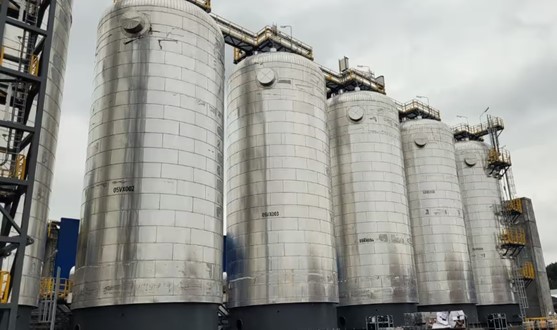
Norway's Carbon-Free Concrete Plant Aims to Revolutionize the Cement Industry
A slender metal tower, recently erected at the mouth of a fjord two hours southwest of Oslo, stands as a potential milestone in the global energy transition. This 100-meter-tall structure, part of Heidelberg Materials' plant in Brevik, Norway, is designed to capture carbon dioxide emitted from a nearby cement facility, marking a significant step towards carbon-free concrete production. Set to be completed by the year's end, this facility will be among the first worldwide to integrate carbon capture technology in cement production.
The success of such projects could ignite a wave of investments in carbon-neutral concrete, playing a crucial role in achieving global climate goals by 2050. However, if these initiatives falter, either environmentally or financially, they could hinder the progress of a technology that the cement industry is heavily relying on to achieve a third of its carbon reduction targets by mid-century.
Chris Bataille, a researcher at Columbia University and co-author of the latest IPCC report on climate solutions, emphasized the importance of these initial plants in reducing costs and risks for future projects. "Just as solar and wind power emerged in the 1970s and have become mainstream by the 2020s, the cement industry is still stuck in the 1970s in terms of innovation," he stated.
Concrete production is a major contributor to global warming, outpacing even the aviation and fast fashion industries in its impact. Despite some manufacturers' efforts to use cleaner fuels and recycle industrial waste, they have struggled to curb emissions from key chemical processes responsible for about 60% of the industry's carbon footprint.
At the Brevik plant, project manager Anders Petersen pointed to the piles of grey limestone and black coal, explaining that both materials release carbon dioxide when processed at high temperatures. However, the carbon captured at this plant will soon be stored in liquid form, as part of the facility's efforts to reduce its environmental impact.
Carbon capture and storage (CCS) is a central component of the International Energy Agency and IPCC's roadmaps for a clean economy. Yet, CCS has been criticized for its high costs, energy intensity, and mixed reliability. Environmentalists have also condemned the practice of using captured carbon to extract more oil, viewing it as a form of greenwashing that enables further fossil fuel extraction.
Nonetheless, within the cement industry, CCS remains the most developed technology for carbon reduction. Frederic Hauge, founder of the Norwegian environmental organization Bellona, noted that public attitudes are shifting as the scale of the climate challenge becomes more apparent. "The real question is, what is the cost of inaction on CCS? Without it, we could face catastrophic consequences," he warned during a press tour of the Brevik facility.
While the cement sector has faced minimal pressure to reduce emissions, rising carbon prices and growing demand for sustainable alternatives are beginning to drive change. The EU's emissions trading scheme will gradually eliminate free allowances for industries by 2034, and companies like Heidelberg Materials are already benefiting from subsidies as early adopters. The firm is also mindful of maintaining its social "license to operate."
Heidelberg Materials plans to transport the captured carbon from Brevik via ship, pipeline, and finally inject it 2.5 kilometers beneath the Norwegian seabed. This initiative is part of Norway's "Longship" project, which aims to establish the world's first cross-border carbon capture and storage infrastructure. More than 80% of the funding for the Brevik CCS project comes from the Norwegian government.
Domien Vangenechten, an analyst at the climate think tank E3G, described the Brevik project as a significant development for the cement industry but cautioned against relying solely on CCS. He advocated for complementary strategies, such as reducing the use of clinker (a highly polluting intermediate product), designing more efficient buildings, and cutting demand for concrete to avoid overburdening producers and taxpayers.
The initial test for CCS in the construction industry will be its ability to deliver the promised emissions reductions. The Brevik plant, which primarily uses waste heat for the capture process, can currently only capture emissions from half of its production, with a target of 90% reduction. Heidelberg Materials has launched a dozen more CCS projects across Europe and North America, aiming for even higher capture rates above 95% in some cases.
The second major challenge is the cost. Although Heidelberg Materials has not yet set a price for its carbon-free cement, it acknowledges that the product will initially be a niche offering due to the substantial upfront investments required. "Cement with CCS will always be more expensive than traditional cement," said Gernot Wagner, a climate economist at Columbia Business School. "The green premium in cement is real."
For consumers, the positive news is that climate-friendly cement is expected to add only a small amount to the overall cost of an apartment. However, while automakers have driven early investments in green steel by signaling a willingness to pay more, there is currently no clear lead market for clean concrete.
"There is still much less demand for green cement compared to steel," said Julia Attwood, an industrial decarbonization analyst at BloombergNEF. She urged real estate developers and owners of large commercial buildings to pressure their suppliers to source environmentally friendly materials.
In February, the new Nobel Centre in Stockholm became one of the first projects to commit to Brevik's carbon-captured net-zero concrete. Heidelberg Materials anticipates that other early adopters may include sustainable architecture firms, tech companies with large data centers, and public authorities with stringent green procurement policies. However, widespread adoption may take time.
The key now is to learn quickly from these early projects and drive down costs, according to Wagner, "to turn low-carbon cement from a novelty into a mainstream commodity."